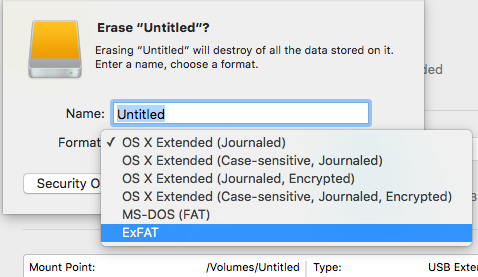

- HOW TO FORMAT A DRIVE FOR MAC AND WINDOWS HOW TO
- HOW TO FORMAT A DRIVE FOR MAC AND WINDOWS DRIVER
- HOW TO FORMAT A DRIVE FOR MAC AND WINDOWS PORTABLE
- HOW TO FORMAT A DRIVE FOR MAC AND WINDOWS PRO
Step 3: Select “Mac OS Extended (Journaled)” in Format.Ī new window will pop up asking which file system you’d like to format the external drive to. Click on this icon on the top left corner and select “Show All Devices”. Note: if your hard drive is not showing on the left panel, it must have been hidden. Select that disk and click the “Erase” button, the one highlighted in red in the screenshot below. It should show up on the left panel under “External”. Step 2: Highlight your external drive and click “Erase”. The quickest way to do this is a simple Spotlight search (click the search icon on the upper right corner), or go to Applications > Utilities > Disk Utility. They might be different if your Mac has a different version. Note: The tutorial and screenshots below are based on macOS Sierra 10.12.5.
HOW TO FORMAT A DRIVE FOR MAC AND WINDOWS HOW TO
How to Format an External Drive for Mac (from NTFS to Mac OS Extended) The problem is that on macOS, you can’t work with files saved on an NTFS drive unless you use a paid app like Paragon NTFS for Mac. What is NTFS? I’m not going to explain here you can read more on Wikipedia. I then right-clicked the external drive icon on Mac desktop > Get Info. If I wanted to use it with Mac OS or Time Machine backup (which is my intent), I’ll need to format the drive for my Mac. It brought me to a webpage on Seagate’s site, where it clearly indicated the drive was initially set up to work with a Windows PC. Since I wanted to use it on Mac, I clicked the blue logo with the text “Start_Here-Mac”. When I opened it, the default content was all there. When I connected the Seagate to my Mac, the drive icon showed up like this.
HOW TO FORMAT A DRIVE FOR MAC AND WINDOWS PRO
Three weeks ago, I bought a brand new 2TB Seagate Expansion to backup my MacBook Pro before I updated it to the latest macOS. Most External Hard Drives Are Initiated with NTFSĭuring the last several years, I’ve used a few external drives, including a 500GB WD My Passport, 32GB Lexar flash drive, and a few others. I highly recommend you also create multiple partitions. Pro tip: If your external drive has a large volume, like mine – a 2TB Seagate Expansion.

The operation will erase all data and your files will be gone for good. Important note: If you have useful files stored on the external drive, be sure to copy or transfer them to another safe place prior to formatting. Just follow this easy step-by-step guide and you’re all set. In this post, I’m going to show you how to format your external drive for a Mac-compatible file system i.e. Apple Mac machines support a different file system. That’s all because it’s been initialized with Windows NT File System (NTFS), which is primarily for PCs. But somehow, macOS doesn’t allow you to write data to the drive.
HOW TO FORMAT A DRIVE FOR MAC AND WINDOWS PORTABLE
If you don't want to spend any money and don't have a Seagate drive, an alternative is to format your drive in the exFAT format, which is a Microsoft file system optimized for flash memory such as USB flash drives and SD cards, and is supported on both MacOS and Windows.So, you just bought a new external hard drive or a portable SSD and wanted to use it on your Mac.
HOW TO FORMAT A DRIVE FOR MAC AND WINDOWS DRIVER
What's even better, if your drive is a Seagate you can download this version for free:Īlternately, if you are running a Windows machine and need to read and write Mac HFS+ disks, Paragon also make a driver utility for Windows too: This costs about $20, but is worth every penny if you do any kind of cross-platform work. If you want to write to NTFS on a Mac, the best solution is: Macs can read NTFS, but normally can't write to it. The most common Windows drive format is the NTFS system, which modern Windows machines use by default, and which is the format most hard drives come with as standard. Is this still correct?įAT32 is supported on both Windows and MacOS but is not recommended(especially for audio files) because of its file size limits. My previous understanding was that only FAT32 is supported between platforms. Especially so I can save iConnectivity drivers, updates etc. I'd like to have at least one external, USB HDD formatted to work on both Mac & PC.


 0 kommentar(er)
0 kommentar(er)
